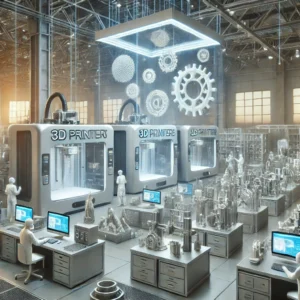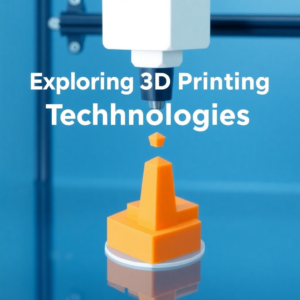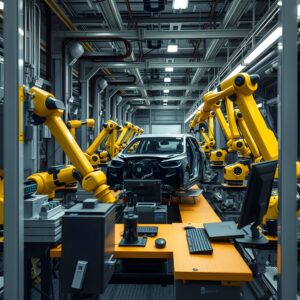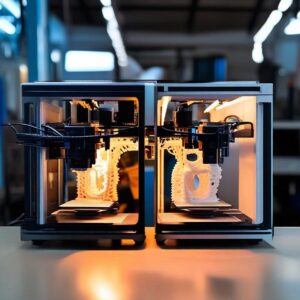2024 Breakthroughs in 3D Printing for Manufacturing
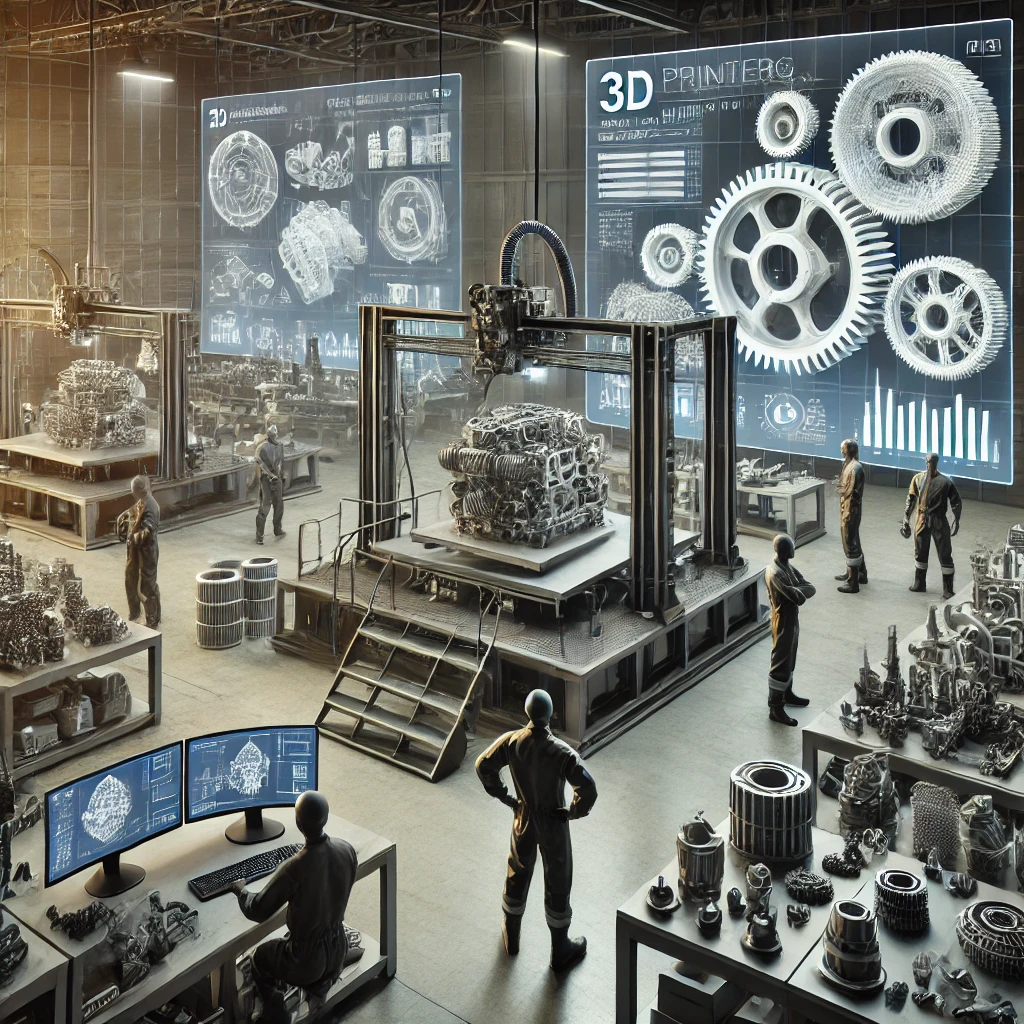
Explore 2024’s breakthroughs in 3D printing, from faster production and advanced materials to precision enhancements and industry-transforming applications.
3D Printing for Manufacturing
The year 2024 has brought significant advancements in 3D printing, solidifying its role as a transformative force in manufacturing. Known for its precision and efficiency, 3D printing, or additive manufacturing, creates objects layer by layer using digital designs. This technology has evolved to address industry demands for speed, scalability, material innovation, and sustainability. Once limited to prototyping, it is now widely used in mass production across aerospace, healthcare, automotive, and construction industries.
The breakthroughs in 3D printing this year address key challenges, such as enhancing production speeds, expanding material options, and improving integration with advanced technologies like artificial intelligence (AI) and the Internet of Things (IoT). These innovations enable the technology to meet the growing demand for efficient and eco-friendly manufacturing solutions.
As 3D printing continues to revolutionize manufacturing processes, its potential applications grow broader and more impactful. This article delves into the history of 3D printing, the major advancements of 2024, and how these changes are shaping industries. By exploring its benefits, limitations, and future opportunities, we gain a clearer understanding of the pivotal role 3D printing plays in modern manufacturing.
The Evolution of 3D Printing in Manufacturing
The Early Beginnings
The origins of 3D printing date back to the 1980s when it was primarily used for prototyping. Early technologies like stereolithography (SLA) and fused deposition modeling (FDM) provided engineers and designers with a means to create physical models from digital designs. These prototypes allowed for quick design iterations without the high costs associated with traditional manufacturing.
Initially, the technology was seen as a niche solution for creating small-scale, non-functional models. However, the ability to produce complex geometries made it an appealing option for industries that required innovative design approaches. By the early 2000s, researchers and engineers began exploring its potential beyond prototyping.
Expansion into Functional Applications
As material science improved, 3D printing found its way into functional applications. Industries like aerospace and healthcare started using it to create lightweight components, custom medical implants, and tools. The ability to produce intricate designs that traditional methods could not achieve opened new possibilities for manufacturing.
The automotive industry also embraced 3D printing for prototyping and producing small-scale parts. Manufacturers appreciated the flexibility of creating parts on-demand, reducing inventory costs and lead times. By the mid-2010s, it became evident that additive manufacturing was more than just a prototyping tool—it was a game-changing technology.
Growth During the Pandemic Era
The global pandemic of 2020 accelerated the adoption of 3D printing. The technology’s adaptability allowed manufacturers to address supply chain disruptions by producing essential items such as ventilator components and personal protective equipment. This period highlighted the value of on-demand production and cemented 3D printing as a critical tool for rapid response.
Shifts in Industrial Manufacturing
By 2020, improvements in printer capabilities and the availability of high-performance materials led to the adoption of 3D printing for industrial-scale manufacturing. Aerospace and automotive industries integrated it into their production lines, using it to create end-use parts and optimize workflows.
Today, 3D printing is no longer limited by its earlier constraints. In 2024, breakthroughs have addressed speed, scalability, and material limitations, making the technology a viable option for mass production.
Breakthroughs in 3D Printing in 2024
Faster and Scalable Production
Speed Innovations in 2024
Production speed has always been a limiting factor for 3D printing, but 2024 has seen revolutionary advancements in this area. Continuous Liquid Interface Production (CLIP) and Multi Jet Fusion (MJF) technologies have been optimized to drastically reduce printing times. These methods use innovative curing and fusion processes to build parts at speeds previously unattainable.
Scaling Up with Larger Printers
Large-scale 3D printers are becoming more accessible and efficient. These machines can now produce full-scale components such as car frames, wind turbine blades, and even building structures. This advancement is closing the gap between traditional manufacturing and 3D printing, making it suitable for high-volume production.
Automation and Workflow Integration
Automation is transforming additive manufacturing into a scalable solution. Robotic arms and conveyor systems seamlessly integrate with 3D printers, handling tasks like material loading and part removal. This level of automation enables continuous, round-the-clock manufacturing.
Batch Printing with Multi-Nozzle Systems
Multi-nozzle printers are another key innovation. By producing multiple components simultaneously, these machines optimize efficiency for batch production. This breakthrough allows manufacturers to meet growing market demands without sacrificing quality or precision.
Applications in On-Demand Manufacturing
Faster production times and scalability are enabling on-demand manufacturing across industries. Companies can now respond quickly to market fluctuations, producing parts or products as needed. This agility reduces inventory costs and improves customer satisfaction.
Material Advancements in 3D Printing
Expanding Material Choices
Material innovation has taken center stage in 2024. High-performance polymers such as PEEK and ULTEM are now widely available, offering excellent heat resistance, strength, and chemical stability. These materials are especially valuable in aerospace and healthcare applications.
Breakthroughs in Metal Printing
Metal 3D printing has seen significant advancements, particularly in the development of new alloys like titanium-aluminum and cobalt-chrome. These materials are lightweight yet durable, making them ideal for industries that require high-performance components.
Sustainability and Recycling
Sustainability is driving material innovation. Recycled filaments and bio-based resins are being used to create eco-friendly products. These materials align with global efforts to reduce environmental impact and promote sustainable practices.
Multi-Material Capabilities
Printers capable of handling multiple materials in a single print have become more common. This capability enables the creation of parts with diverse properties, such as combining rigid exteriors with flexible interiors or integrating conductive elements for electronics.
Customized Materials for Specific Needs
Industries are also exploring proprietary materials tailored to their unique requirements. For example, ceramic-based materials for high-temperature applications and conductive polymers for advanced electronics are gaining popularity.
Precision and Quality Enhancements
Precision is one of the hallmarks of 3D printing, and the advancements in 2024 have taken it to new levels. As the demand for high-quality, intricate designs continues to grow, manufacturers are pushing the boundaries of what 3D printing technology can achieve. Improvements in hardware, software, and materials have all contributed to enhanced precision and quality control.
Achieving Sub-Micron Accuracy
Modern 3D printers are now capable of achieving sub-micron accuracy, ensuring that even the smallest details in a design are captured with unparalleled fidelity. This capability is particularly critical in industries like electronics, where components often need to be miniaturized. Medical applications, such as dental implants and hearing aids, also benefit from this level of precision, as they require a perfect fit and intricate details.
Layer-by-Layer Monitoring Systems
Real-time monitoring systems have become a standard feature in advanced 3D printers. These systems use cameras, sensors, and AI algorithms to analyze each layer as it is printed. By detecting errors or inconsistencies early, manufacturers can make adjustments on the fly, reducing waste and ensuring consistent quality.
Automated Quality Assurance
Quality assurance processes have also been streamlined with automation. Once a part is printed, it undergoes non-destructive testing, such as X-ray scanning or ultrasound analysis, to ensure structural integrity. These systems are particularly valuable in industries where defects could lead to catastrophic failures, such as aerospace or automotive.
Improved Material Uniformity
Material science innovations have led to better uniformity in 3D printing materials, reducing the likelihood of inconsistencies during the printing process. These advancements ensure that mechanical properties, such as strength and flexibility, are evenly distributed throughout the printed part.
Post-Processing Innovations
While traditional 3D printing required significant post-processing to achieve smooth finishes and remove support structures, 2024 has seen a reduction in these steps. Advanced printers now use optimized support structures that are easier to remove, and new printing techniques produce smoother surfaces directly from the machine.
Surface Finishing Technologies
Innovative surface finishing technologies are also playing a crucial role in quality enhancement. Processes such as chemical polishing, laser smoothing, and electroplating have become more precise and efficient, allowing for the creation of parts that meet stringent aesthetic and functional requirements.
High-Resolution Printing in Bioprinting and Microfabrication
Bioprinting and microfabrication have benefited immensely from these quality improvements. In bioprinting, the ability to accurately replicate the complex structures of tissues and organs is essential for successful implantation and research. Similarly, microfabrication for electronics and photonics relies on high-resolution printing to achieve the necessary level of detail.
Applications of 3D Printing in Manufacturing
3D printing’s applications are expanding across industries, demonstrating its versatility and efficiency. In 2024, the technology is not only being used for prototyping but also for creating end-use products, tools, and infrastructure. Each application showcases the transformative potential of additive manufacturing.
Aerospace and Defense
The aerospace industry continues to lead the adoption of 3D printing. Lightweight components, such as brackets, fuel nozzles, and turbine blades, are being produced using advanced materials like titanium alloys. These parts offer high strength-to-weight ratios, improving fuel efficiency and reducing emissions. On-demand manufacturing also enables quick replacement of parts in remote or challenging environments, making it invaluable for defense operations.
Healthcare and Bioprinting
In healthcare, 3D printing is revolutionizing patient care. Customized implants and prosthetics, tailored to individual anatomies, are improving outcomes for patients worldwide. Bioprinting is another groundbreaking application, with researchers developing functional tissues and organs for transplantation. The technology is also being used to produce surgical guides, enabling more precise procedures.
Automotive Industry
The automotive sector is leveraging 3D printing for prototyping, tooling, and end-use parts. Lightweight components, such as engine mounts and brackets, contribute to fuel efficiency and reduce overall vehicle weight. Customization is another advantage, allowing manufacturers to produce unique parts for high-end or specialty vehicles.
Consumer Goods
3D printing is reshaping the consumer goods industry by enabling mass customization. Companies are producing everything from personalized footwear to intricate jewelry designs. The technology also supports sustainable practices by using recycled materials and reducing production waste.
Construction and Architecture
In construction, large-scale 3D printers are being used to create building components and even entire structures. This approach reduces construction timelines, minimizes material waste, and allows for greater design freedom. Architects are also using 3D printing to create detailed models, bringing their designs to life with unprecedented accuracy.
Electronics and Energy
The electronics industry is exploring 3D printing for applications such as circuit boards and microdevices. Energy companies are using the technology to produce components for wind turbines and solar panels, contributing to renewable energy initiatives.
Education and Research
Educational institutions are integrating 3D printing into their curricula, teaching students about design, engineering, and manufacturing. Researchers are also using the technology to develop prototypes for experiments, accelerating innovation across various fields.
Integration with Smart Manufacturing
3D printing is becoming an integral part of smart manufacturing ecosystems. By combining additive manufacturing with technologies like IoT, AI, and digital twins, industries are achieving greater efficiency, precision, and flexibility.
IoT-Enabled Printers
IoT-enabled printers allow for real-time monitoring and remote operation. Manufacturers can track production metrics, diagnose issues, and adjust settings from anywhere in the world. This connectivity enhances efficiency and reduces downtime.
Digital Twins and Simulation
Digital twins are virtual replicas of physical parts that allow manufacturers to simulate performance before production. This technology reduces errors, shortens development cycles, and improves product quality. By integrating digital twins with 3D printing, companies can optimize designs and test various scenarios without creating physical prototypes.
AI-Driven Optimization
AI is revolutionizing 3D printing by analyzing data and optimizing print parameters. Machine learning algorithms can predict potential issues, suggest improvements, and enhance overall production efficiency. This level of intelligence ensures consistent quality and minimizes material waste.
Predictive Maintenance
Predictive maintenance systems use IoT data to identify potential printer failures before they occur. By addressing issues proactively, manufacturers can avoid costly downtime and extend the lifespan of their equipment.
Cloud-Based Manufacturing Platforms
Cloud-based platforms are enabling seamless collaboration across teams and geographies. Designers can upload their files, manufacturers can access them in real time, and production can be initiated almost instantly. These platforms are streamlining workflows and making 3D printing more accessible.
Integration with Robotics
Robots are being integrated into 3D printing workflows to handle tasks like material loading, part removal, and assembly. This automation reduces labor costs, improves consistency, and enables 24/7 manufacturing operations.
Data-Driven Decision Making
The wealth of data generated by IoT-enabled printers and AI systems is empowering manufacturers to make informed decisions. By analyzing trends and identifying inefficiencies, companies can continuously improve their processes and stay competitive in the market.
FAQs
1. What industries are benefiting the most from 3D printing in 2024?
Aerospace, healthcare, automotive, and construction industries are among the top beneficiaries. They use 3D printing for applications ranging from lightweight components to custom medical implants and large-scale construction projects.
2. How does 3D printing contribute to sustainability?
3D printing reduces waste by using only the necessary material for each part. It also supports the use of recycled and bio-based materials, aligning with global sustainability goals.
3. What are the key advancements in 3D printing in 2024?
Breakthroughs include faster production speeds, larger build volumes, improved material diversity, enhanced precision, and integration with smart manufacturing technologies like IoT and AI.
4. What challenges does 3D printing still face?
Challenges include high initial costs, limited material compatibility, and slower adoption in traditional manufacturing sectors. However, ongoing research is addressing these limitations.
5. How is AI improving 3D printing?
AI enhances 3D printing by optimizing print settings, predicting potential issues, and ensuring consistent quality. It also supports predictive maintenance and real-time adjustments for better efficiency.
6. What role does bioprinting play in healthcare?
Bioprinting is revolutionizing healthcare by enabling the creation of functional tissues and organs. It is also used for developing custom implants, prosthetics, and surgical tools with unmatched precision.
7. How will 3D printing evolve in the future?
The future of 3D printing includes advancements in bioprinting, fully automated factories, and the use of advanced composites. Continued innovation will expand its applications and further integrate it into global manufacturing systems.
For other insights and projects, be sure to explore our Key Technologies in 3D Printing or Uses of 3D Printing column

